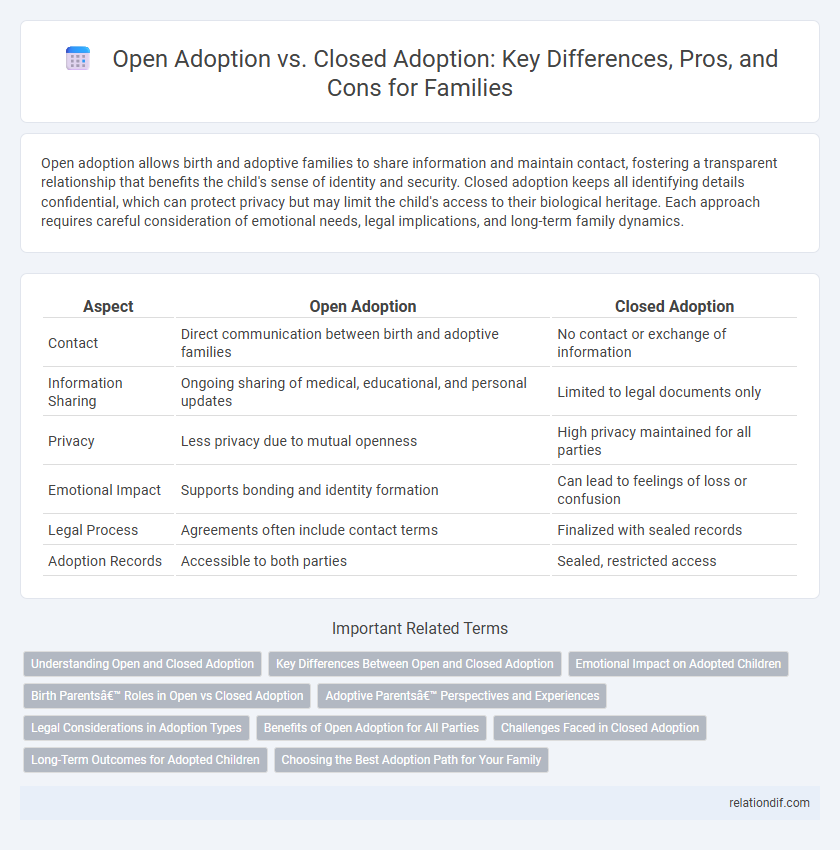Open adoption allows birth and adoptive families to share information and maintain contact, fostering a transparent relationship that benefits the child's sense of identity and security. Closed adoption keeps all identifying details confidential, which can protect privacy but may limit the child's access to their biological heritage. Each approach requires careful consideration of emotional needs, legal implications, and long-term family dynamics.
Table of Comparison
| Aspect | Open Adoption | Closed Adoption |
|---|---|---|
| Contact | Direct communication between birth and adoptive families | No contact or exchange of information |
| Information Sharing | Ongoing sharing of medical, educational, and personal updates | Limited to legal documents only |
| Privacy | Less privacy due to mutual openness | High privacy maintained for all parties |
| Emotional Impact | Supports bonding and identity formation | Can lead to feelings of loss or confusion |
| Legal Process | Agreements often include contact terms | Finalized with sealed records |
| Adoption Records | Accessible to both parties | Sealed, restricted access |
Understanding Open and Closed Adoption
Open adoption allows birth families and adoptive families to share information and maintain contact, providing transparency and ongoing communication that supports the child's sense of identity. Closed adoption keeps identifying information confidential, with no direct contact between birth and adoptive families, which can protect privacy but may limit the child's access to their biological background. Understanding these differences helps families choose the adoption style that best suits their emotional needs and long-term goals.
Key Differences Between Open and Closed Adoption
Open adoption involves ongoing contact between birth parents, adoptive parents, and the child, facilitating communication and relationship building, whereas closed adoption keeps identities and information confidential with no interaction. In open adoption, legal agreements often outline the level of contact and information sharing, while closed adoption typically seals records to protect privacy and anonymity. The choice impacts emotional dynamics and access to medical history, with open adoption offering transparency and closed adoption prioritizing privacy.
Emotional Impact on Adopted Children
Open adoption provides adopted children with access to their birth families, fostering a sense of identity and reducing feelings of abandonment and anxiety. In contrast, closed adoption often leaves children with unanswered questions about their origins, leading to potential emotional struggles such as confusion and loss. Studies show that open adoption can enhance emotional well-being by promoting transparency and ongoing connection.
Birth Parents’ Roles in Open vs Closed Adoption
Birth parents in open adoption maintain ongoing communication and involvement, enabling them to participate in decisions and establish a relationship with the child and adoptive family. In contrast, closed adoption offers birth parents anonymity, with no direct contact or information exchange after the adoption process is finalized. The level of birth parents' involvement significantly impacts emotional outcomes and the child's sense of identity in both adoption types.
Adoptive Parents’ Perspectives and Experiences
Adoptive parents in open adoptions often report stronger emotional connections and greater satisfaction due to ongoing communication with birth families, which provides access to the child's medical history and cultural background. In contrast, those in closed adoptions may experience challenges such as uncertainty about the child's origins and limited support in addressing identity questions as the child grows. Research indicates that open adoption arrangements contribute to healthier family dynamics and better psychological outcomes for both adoptive parents and children over time.
Legal Considerations in Adoption Types
Open adoption involves legally binding agreements that allow birth parents and adoptive families to maintain contact, requiring clear contracts to protect the rights and expectations of all parties. Closed adoption legally seals original birth records, limiting access to information and contact, which can impact the adoptee's ability to obtain medical history and personal identity details. Adoption laws vary by state, emphasizing the need for legal counsel to navigate privacy rights, consent requirements, and long-term obligations in both open and closed adoption arrangements.
Benefits of Open Adoption for All Parties
Open adoption fosters transparency and ongoing communication between birth parents, adoptive parents, and the child, promoting trust and emotional well-being. It allows birth parents to remain part of the child's life, providing valuable medical history and personal background essential for the child's identity development. Adoptive families benefit from the supportive relationship, gaining reassurance and a shared commitment to the child's best interests.
Challenges Faced in Closed Adoption
Closed adoption presents significant challenges, including limited access to vital information about biological parents, which can hinder a child's understanding of their heritage and medical history. The lack of communication often creates emotional barriers, leading to feelings of identity confusion and unresolved curiosity for both adoptees and adoptive families. Restricted contact also complicates the formation of relationships that could provide psychological support and a sense of belonging.
Long-Term Outcomes for Adopted Children
Open adoption provides adopted children with ongoing access to biological family information, which supports identity formation and emotional well-being into adulthood. Closed adoption, where contact and information are restricted, may lead to challenges in identity development and potential feelings of loss or confusion over time. Studies demonstrate that long-term outcomes improve when adoptees have the opportunity to understand their origins while maintaining stable family environments.
Choosing the Best Adoption Path for Your Family
Choosing the best adoption path for your family involves evaluating the differences between open adoption and closed adoption, focusing on the level of contact with birth parents. Open adoption allows ongoing communication and relationship-building, which can support identity development and emotional well-being for the child. Closed adoption provides privacy and fewer complexities, appealing to families seeking a clear boundary between adoptive and birth family.
Open adoption vs Closed adoption Infographic

 relationdif.com
relationdif.com